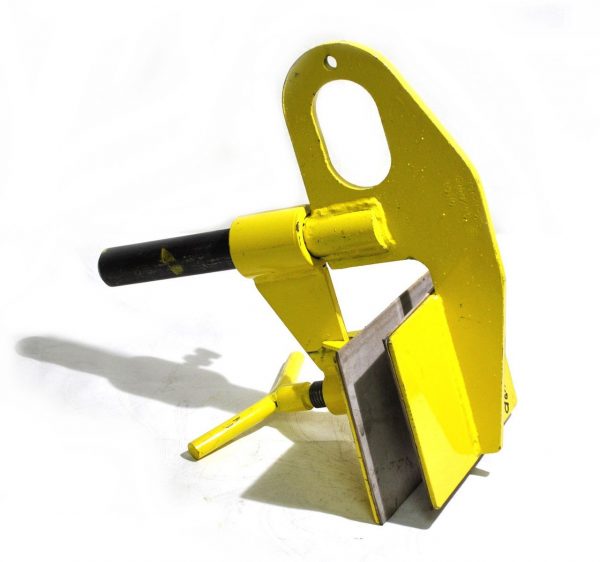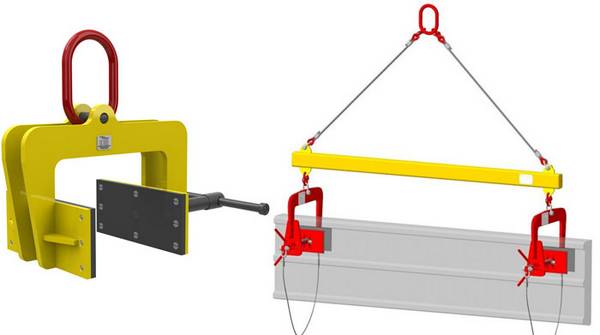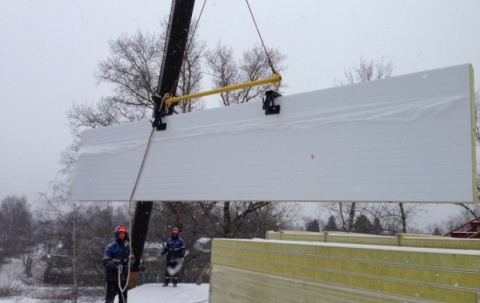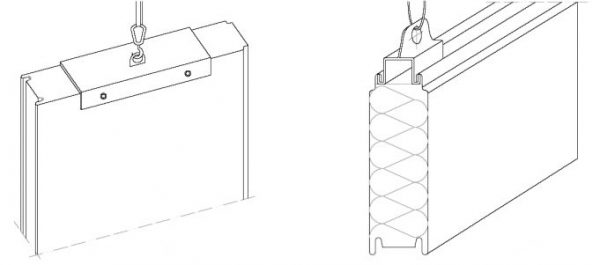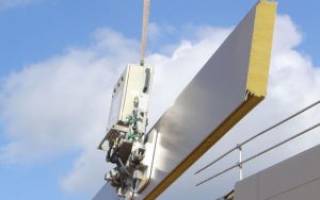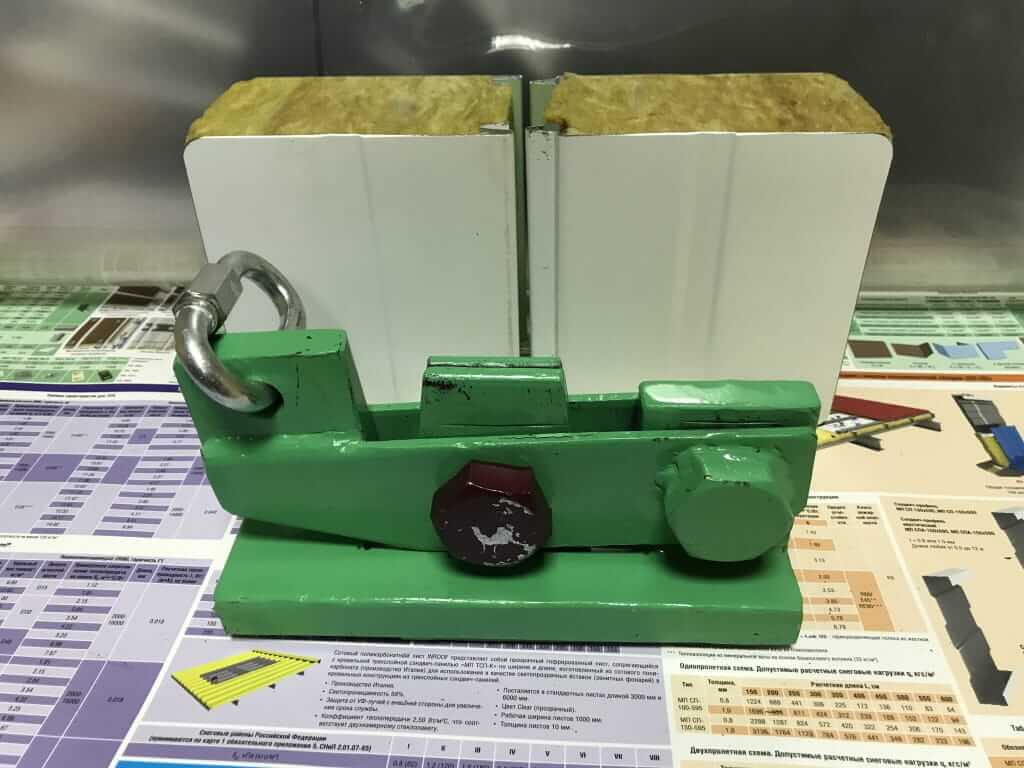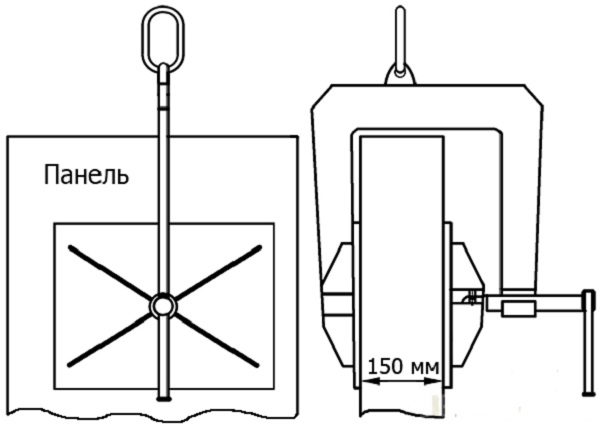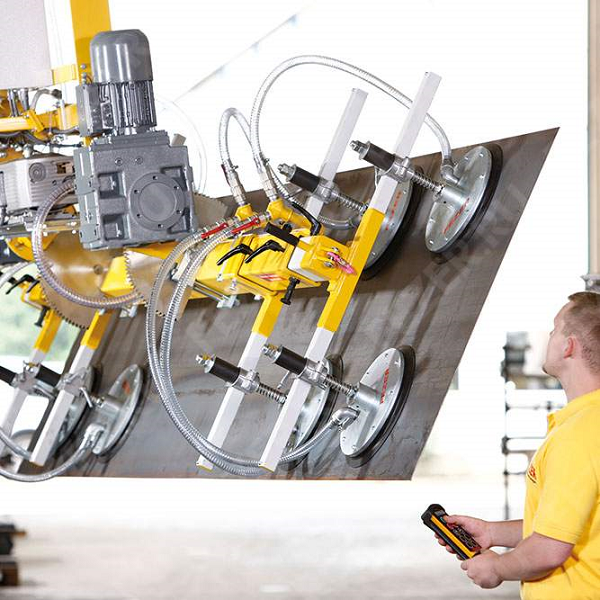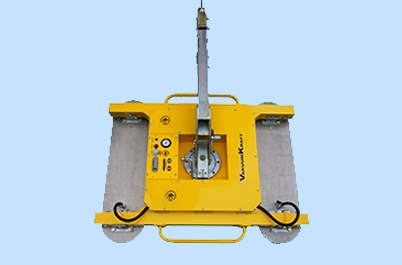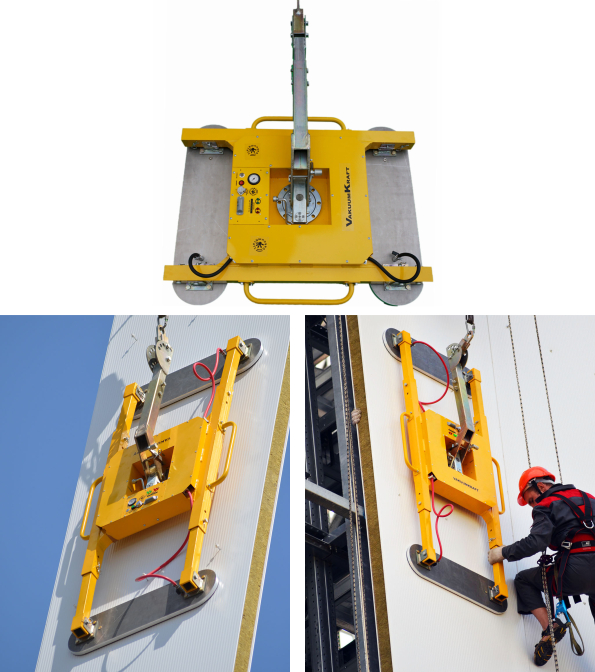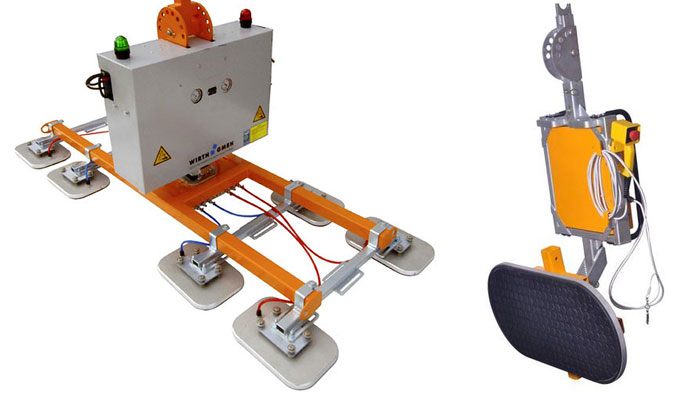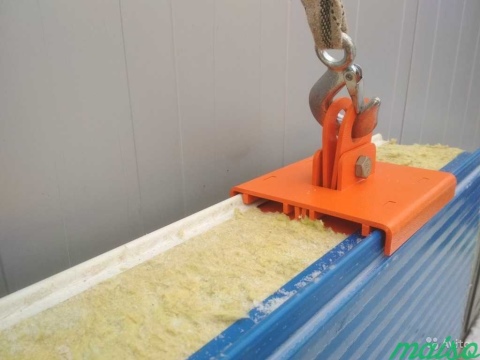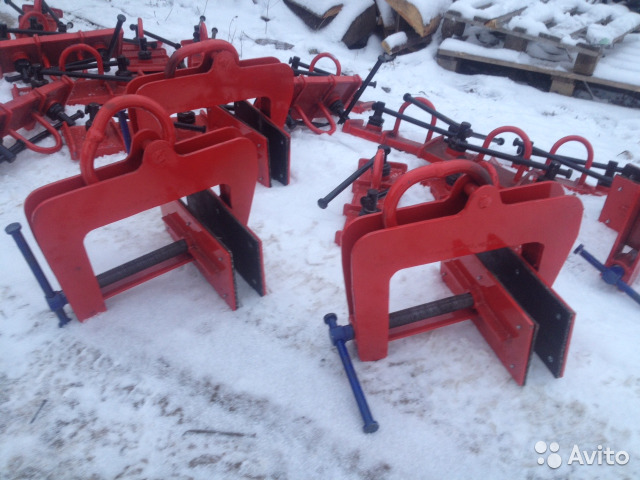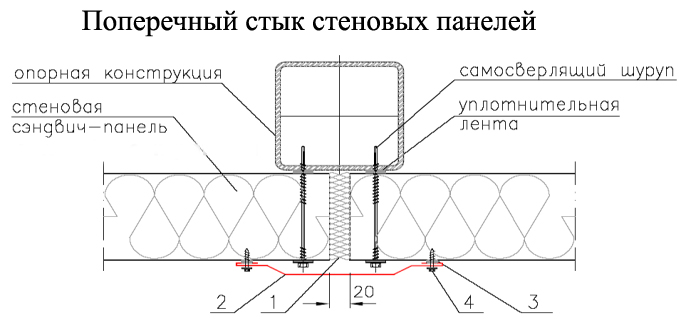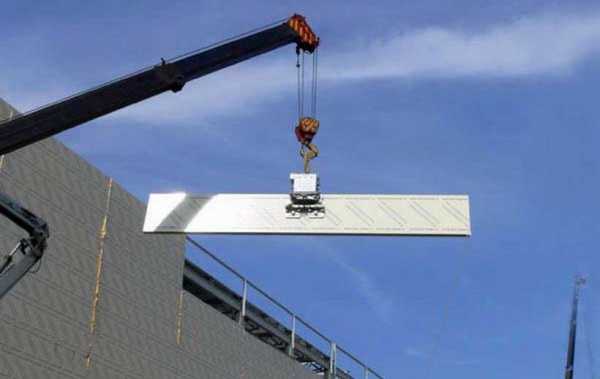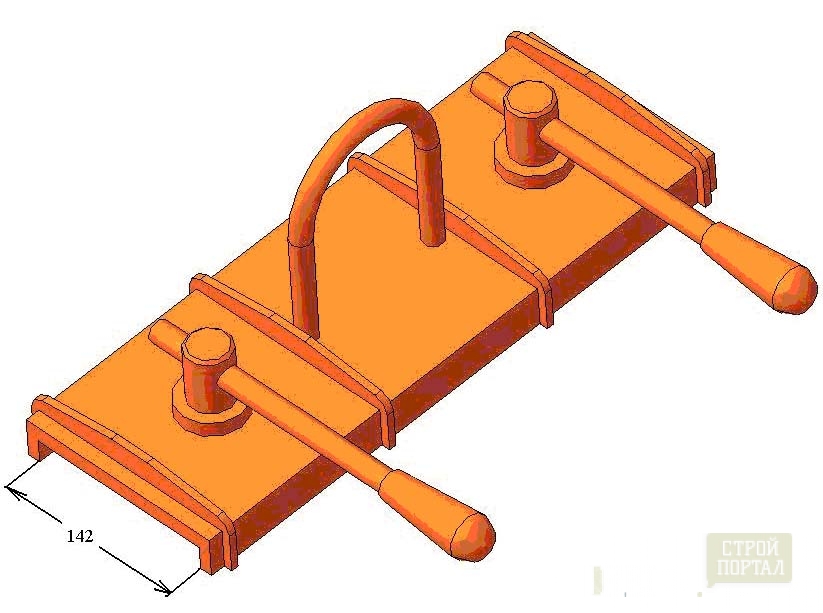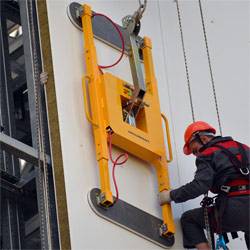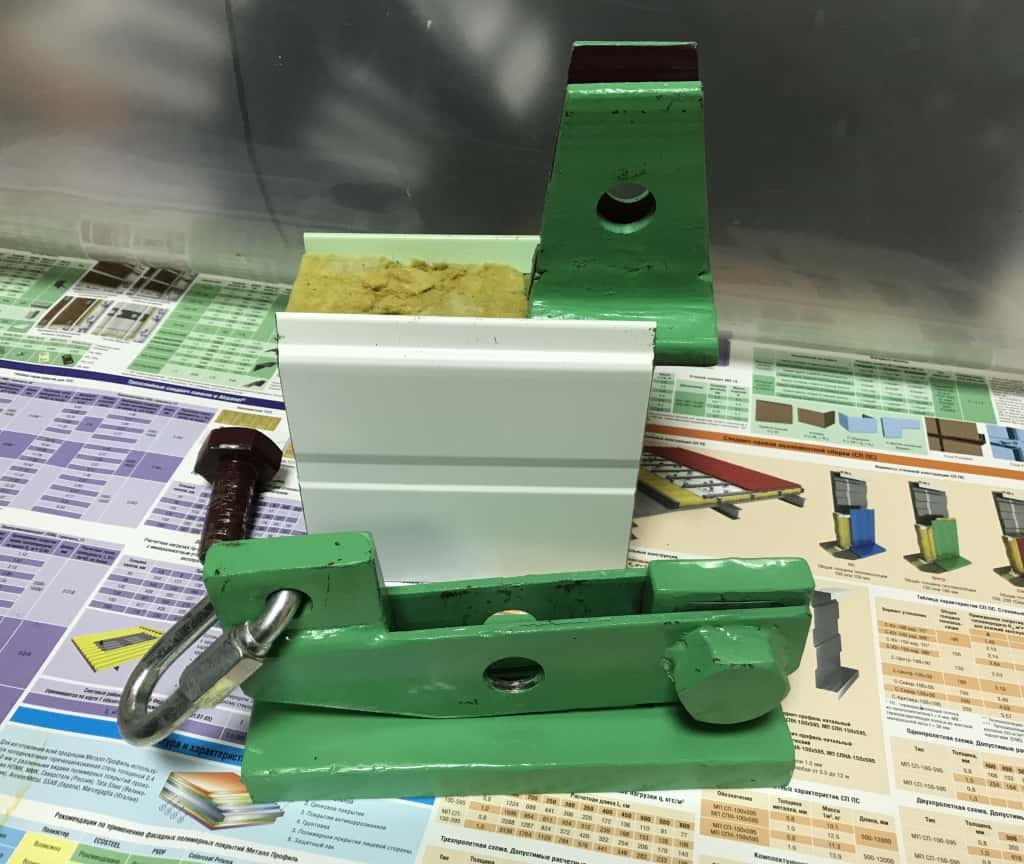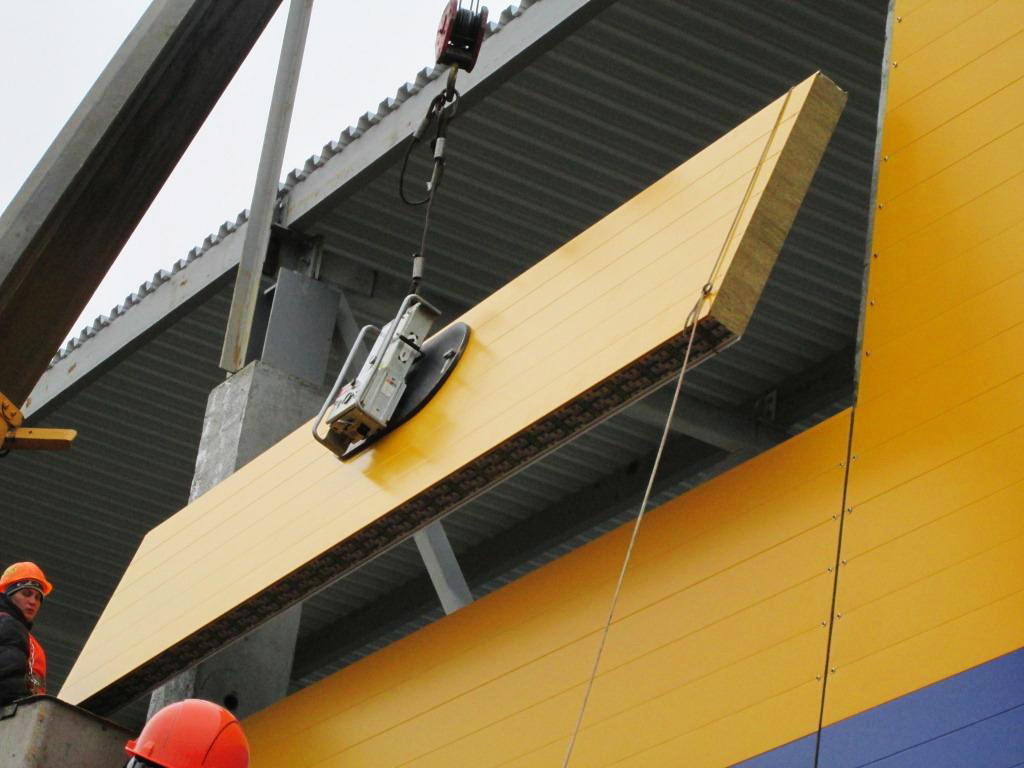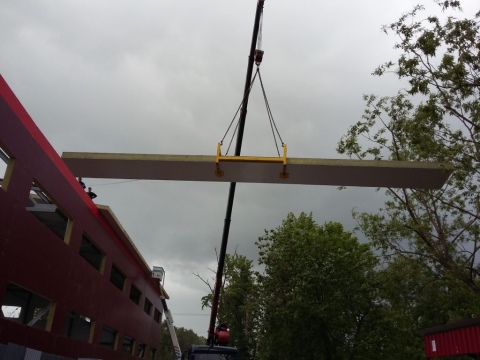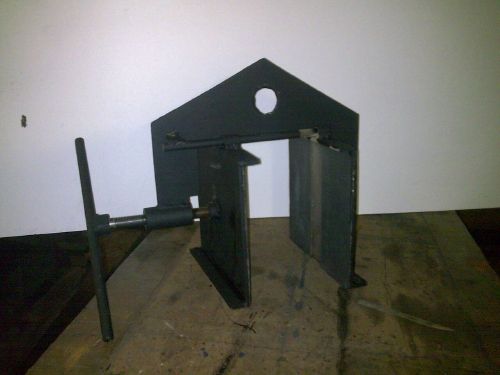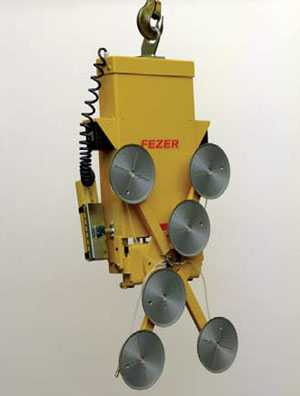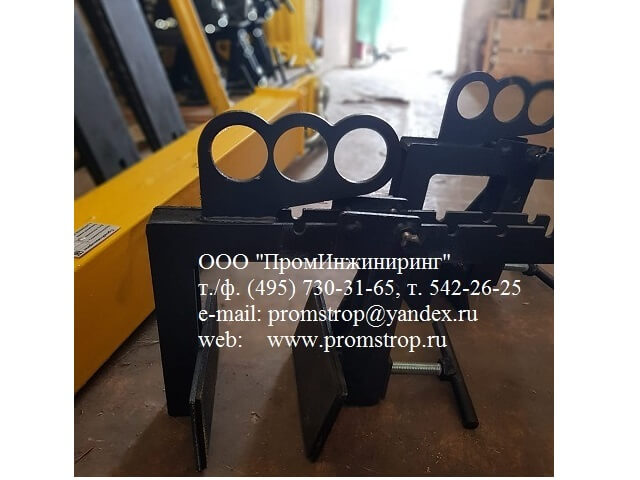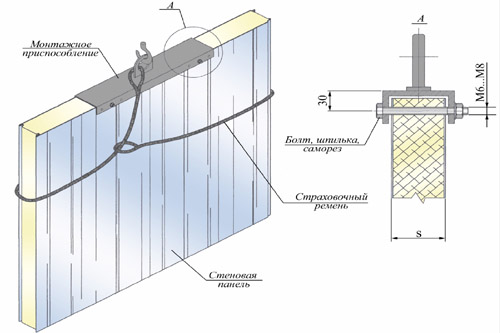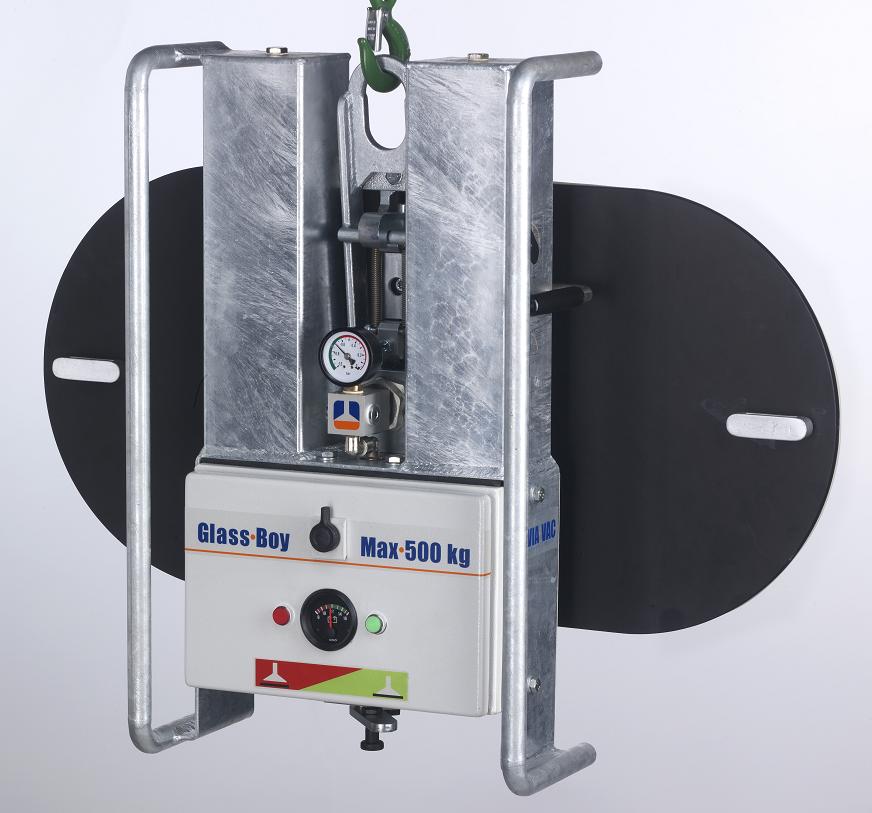Vacuum grippers for sandwich panels
For lifting, moving and installing sandwich panels, one more, more modern and reliable type of load-gripping devices is used - a vacuum gripper (traverse extension). This type of unique equipment can be used with any kind of lifting equipment.
With the help of a vacuum gripper, it is possible to safely and quickly carry out vertical and horizontal installation of roof and wall sandwich panels. Assembly work can also be performed at an angle (installation of a pitched roof), and the profile of the sandwich panel can be of any kind.
Vacuum gripper designs
The design of the vacuum gripper consists of a metal round or rectangular suction cup with a sealing elastic seal - a molded vacuum plate (VP). The material for the manufacture of VP can be: rubber, natural and white rubber, silicone (high-temperature material), nitrile (oil-resistant).
A vacuum pump is connected to the suction cups via a hose. When grabbing the load, the suction cup is placed on its surface and connected to the vacuum pump by turning a special crane. The air-tight seal prevents air from entering the cavity between the weight and the disc, the weight is trapped.
Specialized suction cups and guides are installed between the stiffening ribs of the sandwich panels in the center of the transported material to evenly distribute the load across all suction cups. The number of installed suction cups can be from 1 to 12.
The design of the vacuum gripper also includes a hinge based on a flat spring, thanks to which the gripper is able to independently install on the surface of the transported cargo.
In case of an unexpected shutdown of the vacuum pump, an additional reservoir is attached to it, which allows holding even very heavy sandwich panels for a long time.
This vacuum equipment can be powered by two replaceable batteries. This makes it possible to lift the sandwich panels autonomously, away from power supply sources. The battery capacity lasts up to 250 continuous suction cycles.
The design of this type of grippers also depends on the methods of creating vacuum in the vacuum chamber and the methods of its devacumization.
Benefits of vacuum grippers
Vacuum grippers (traverses) have a number of advantageous features when installing sandwich panels:
- The suction cups ensure the safety of the surface, do not leave damage and do not deform the profile sheets of the sandwich panels at the grip point
- No shift and warping of the panel at the time of its fixation and carrying
- Reliability, ease of fastening
- High speed of installation (per day it is possible to install from 500 to 800 sq. M.)
- Two or three people are enough to mount a sandwich panel sheet.
- High quality of work performed
- Design versatility
- Possibility to change orientation (360 degrees rotation is allowed) sandwich panels in a suspended state
- The breadth of functionality, ease of movement of sandwich panels of non-standard length (up to 26 meters!)
- Simplicity and ease of use
- It is possible to transfer the panel to the installation site directly from the stack, without prior preparation, which gives significant savings in time and space for unloading
The gripper with vacuum suction cups is suitable for mounting metal, fiberboard, PVC, magnesite sandwich panels with all types of fillers.
The cost of vacuum grippers for sandwich panels
It is important to know that when choosing a vacuum gripper for a sandwich panel, its price will directly depend on the manufacturer's brand and on the following technical characteristics:
- Compression force
- Carrying capacity
- Minimum and maximum capture interval
- dimensions
- Panel thickness and weight
- Technological capabilities, availability of additional equipment
When installing sandwich panels, the grippers are very useful lifting devices that greatly facilitate the installation work. With their help, quick-assembled and pre-fabricated structures from sandwich panels, sports facilities, industrial workshops, shopping centers are erected.
Installation of roofing panels: fastening to the purlin, ridge, ebb
Primarily, with the exception of the ridge girders, the panel is fixed to the girder under the ridge using one fastening element.
The outer panels are attached in the upper part of the trapezoid to the purlin with three self-tapping screws; middle - two. Considering the difference in loads in the above-mentioned zones, the recommendations are conditional. The final number and type of fasteners is determined by the working draft.
Upon completion of the main installation work, you must:
- mount the inner ridge strip between the ridge girders
- fill the free space at the joints of the panels with polyurethane foam;
- when the foam hardens, install a polyurethane profile gasket on both sides of the ridge;
In the case of using roofing panels with mineral wool insulation, the joint is filled with mineral wool sealing compound.
The correct organization of the ebb is also important. To ensure proper drainage from the roof surface, the panels in the overhang are trimmed with a strip.
Insulation is cut under the top paneling of the panel, the strip is pushed through and attached to the lower panel. Gutter hooks are attached to the bar, later gutters are inserted, preferably made of PVC.
Features of the device and basic principles of operation
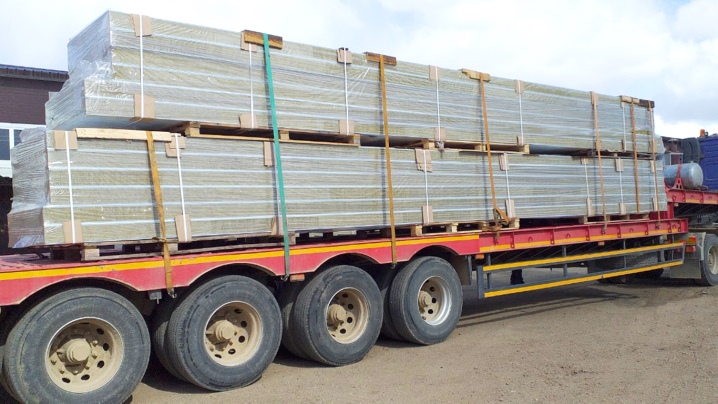
In the situation with mechanical devices, we are talking about structures, the basis of which is a metal frame with an eyelet for fastening rings. The outer wall of the device has holes in which threaded bushings are located. On the opposite side there is a pad made of thick, corrugated rubber.
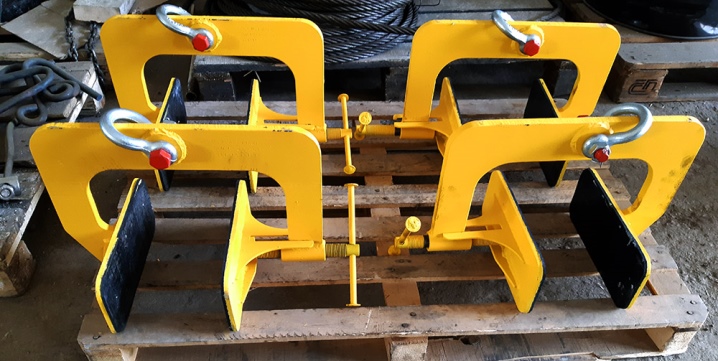
With the help of a threaded connection, the handle is fixed, which also has a rubber pad. Due to its rotation, the sandwich panel is fixed. A similar device is located on the other side of the structure to be installed.
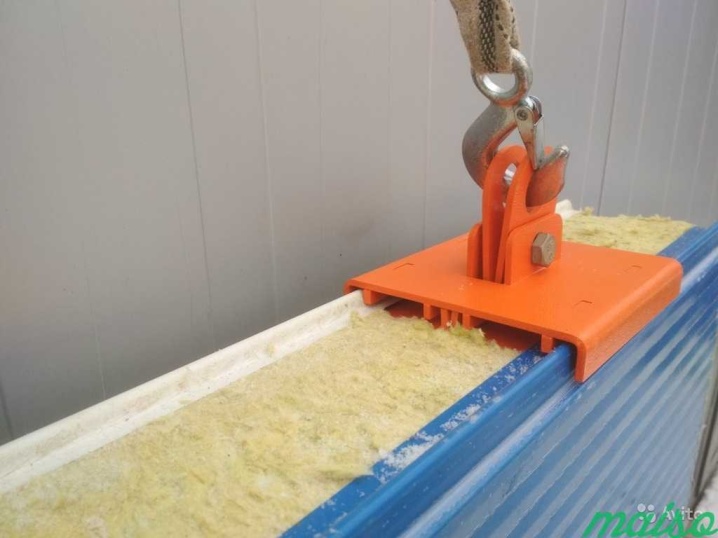
In mechanisms equipped with levers, the fixing unit is located on a lowering part called a rocker arm. In such situations, a counterweight (thrust) is mandatory on the opposite side. Fixation and retention of the movable plate occurs due to the tension of the lever.
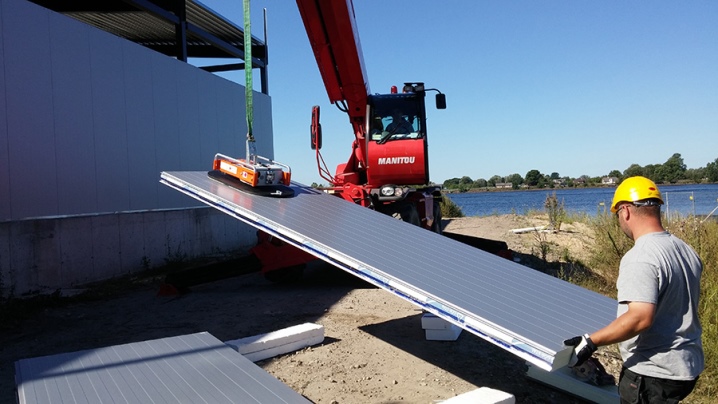
Vacuum grippers are equipped with an additional unit - a drive, and are installed on a crane hook
It is important to remember that devices belonging to this category should be located exclusively in the center of the panel. When the suction cups come into contact with the profile sheet of the plate, the piston of the device moves downward, thereby activating the removal of air from the cylinder through the control valve
As soon as all the air has been expelled and the suction cup is fully connected to the surface of the panel, the chain link will immediately begin to descend until the switch is pressed.
As a result of all the described manipulations, the air outlet is blocked, and therefore, the pressure in the cylinder increases to the maximum. It must be remembered that the clamping force of the suction cups is determined by the weight of the mounted elements of the wall and roof structures. Stable retention of the gripper suction cups is ensured by an equilibrium vacuum installed in the cylinder of the device. And their detachment from the surface of the plate is carried out when all the above operations are performed in the reverse order.
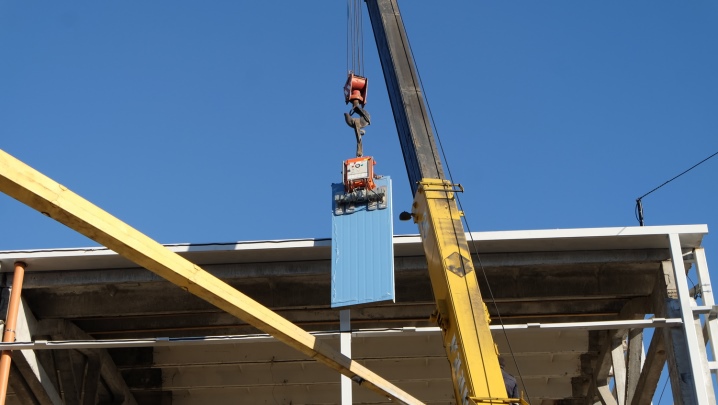
Sandwich panel mounting tools
Despite the simplicity of construction, strength and durability, the three-layer metal sandwich panel requires special treatment. It is strictly forbidden to cut it with an angle grinder, in the common people "grinder", as this can lead to irreversible consequences in the form of a violation of the integrity of the decorative protective polymer layer and a subsequent decrease in performance. In the process of cutting with an abrasive tool, the edges of the cut are heated to extreme temperatures, which provokes the burning of the protective layer, and sparks falling on the painted surface can damage the protective coating.
Recommended installation tools:
- Reciprocating saw;
- Jigsaw;
- An electric drill with an appropriate attachment or screwdriver;
- Plunger pistol;
Mechanical
They are the most common devices due to their low cost compared to similar devices. This type of gripper is lightweight, which allows two workers to use the mechanism.
Mechanical devices allow the panel to be lifted not only in a vertical position, but also horizontally and even at an angle. In this case, the material is firmly held by rubberized working elements. The size of the mechanical fixtures ranges from 5 cm to 25 cm, which allows the use of panels of different sizes.
Mechanical grippers are:
- clamping (lever);
- castle;
- using drilling.
When gripping with a clamp, not only the retention of the material is provided, but there is the possibility of regulating the compression force. The device consists of a screw mechanism with a fixed base frame.
Due to the rotation of the movable device, fixation between the jaws is ensured by means of a lever or a screw. Lever devices are designed for lifting elements no more than 200 kilograms and up to 20 centimeters wide.
Locking devices provide for fastening the spike elements in the groove. In this case, it is necessary to first ensure the vertical arrangement of the panel along the entire length on special spacers in order to avoid deformation of the locking elements, and then move the material in a vertical position.
Grips with the use of drilling provide for making holes in the profile sheets of the panels. In this case, drilling must be carried out strictly perpendicularly. Then the resulting holes are filled with screw elements or other fasteners.
This way of operating mechanical devices provides a lifting capacity.
The main advantage of mechanical grippers is their cost. In addition, to carry out work with mechanical devices, no special devices are required during transportation and work. The devices are lightweight and have a long service life.
Due to the presence of a lever and an axle, an even load on the gripper is carried out.
Advantages of ARLIFT vacuum grippers
The use of durable construction materials and original engineering solutions provides vacuum lifters with a number of advantages:
- weather resistance thanks to moisture traps and hermetically sealed electrical and electronic components;
- trouble-free operation in the temperature range from -20C to + 50C;
- versatility of use (sandwich panels, corrugated board, roofing materials);
- minimum operation time of gripping with a vacuum suction cup (4 seconds);
- the possibility of using additional safety devices (slings);
- the suction cup can be rotated 360 degrees with additional fixation by 90 degrees on each side;
- ease of use and the ability to install without preparatory work.
All ARLIFT vacuum wall sandwich panel grippers have a long-term guarantee (up to 10 years).Capacious and durable rechargeable batteries provide autonomous operation of the device for 2 working shifts, quickly recharge from a household network and do not succumb to the negative effects of low temperatures. For ease of control over the state of the autonomous power supply elements and the operability of the device, a light alarm and a battery charge indicator are implemented. The charger does not need to be monitored when it is charging. Capacitive batteries, they control the charge volume themselves, there will be no damage and deformation of the batteries during prolonged charging, in contrast to cheap analogs that can ruin expensive equipment.
Safety rules for the installation of sandwich panels
Before starting work, prepare workplaces:
- mark hazardous areas;
- protect openings;
- post signs that warn of the danger;
- scaffolding is installed, the height of the fence should not exceed 1m;
- if work is to be done at night or in cloudy weather, provide sufficient illumination of the working areas.
Adults over 18 years of age are allowed to work with sandwich panels. They must complete a safety course.
It is necessary to take into account the weather conditions, especially the wind speed.
There are two methods of panel mounting - vertically and horizontally. The method is chosen before the start of work.
Do not lift loads if their mass is higher than what is allowed by the grab.
It is prohibited:
- operation of faulty or understaffed equipment;
- use lifting equipment if the data on the carrying capacity is poorly read;
- lift damaged loads;
- lift loads when people are under them.
When moving in any direction of sandwich panels using mechanization, lifting is possible only in its longitudinal position. The gripping devices cling to the sheets on the side, less rigid, walls.
Vacuum
The devices are equipped with special suction cups that securely fix the panel. Vacuum devices can be horizontal, vertical or inclined. Vacuum-type devices provide for lifting elements directly from the package. This ensures reliable safety of the element surface.
The principle of operation of vacuum devices consists in attaching the suction cups to the panel and actuating the pump using a lever. Next, the element is lifted to the desired height.
Devices with suction cups can have a large number of holding fixtures, which allows you to lift items of significant weight.
The reliability of the vacuum gripper also lies in the presence of a backup mechanism, which, in the event of a pump breakdown, is able to hold the panel for a long time.
A significant disadvantage of vacuum gripping systems is the cost of equipment: such devices are affordable only for large construction organizations. In addition, the device requires additional equipment and requires special fixation during transportation.
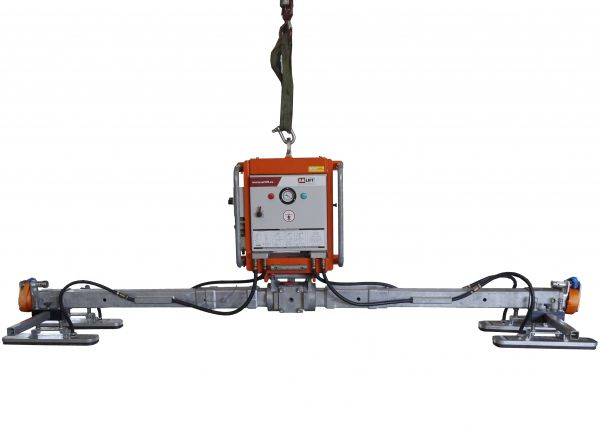
Textile slings
The use of textile slings for lifting wall elements is justified only from an economic point of view. The fact is that the price of slings is not high. But their use will bring many inconveniences associated with fixing and unlatching the load:
- Wall elements on construction sites are laid horizontally, which makes it difficult to attach slings. Sometimes this is generally impossible to do.
- Installed in its permanent place, the panel presses the slings with its weight, which excludes the possibility of freely removing them without moving the wall element.
- The use of slings is limited by the dimensions of the load. Lifting of long sandwich panels is not possible due to the small angle between the sling branches. This can lead to deformation of the wall element and subsequent fracture.
The use of textile slings is justified only in conjunction with mechanical grippers.
What is a seizure and what is it like
Sandwich panels are devoid of elements that would simplify their movement in the air vertically and horizontally, maintaining a vertical position - as, for example, with reinforced concrete panels. Therefore, when assembling the material, they use special equipment - grippers.
Grips are all sorts of devices that attach sandwich panels to lifting machines and deliver them to the required level.
SIP panels are a rather fragile material. Therefore, the gripping device must ensure its integrity and careful movement. There are other requirements for the equipment:
- sufficient grip strength, which will ensure the retention of the load even with a sharp actuation of the crane cable brake;
- ease of work with building material, the ability to rotate, alignment during installation.
Panels are a rather fragile material that is easily damaged by rough handling
The work uses several types of gripping devices:
- textile slings;
- mechanical grippers;
- vacuum apparatus.
Table 1. Cost of grippers of different designs.
| Equipment type | Model | price, rub. |
|---|---|---|
| Vacuum lifter | Morvan | 130 000 |
| Clamp-clamp | Flax-Steel | 4 300 |
| Rope sling | Ocalift | 1 500 |
| Grab for roofing sandwich panels | Ocalift | 21 500 |
This is interesting: How to make a solar collector for a pool with your own hands - a close look at the question
Mechanical type of grippers
Mechanical grippers are divided according to the following characteristics:
- grips of mechanical type - lever, clamp, etc .;
- lifting capacity - up to half a ton kg;
- opening width - depends on the thickness of the wall or roofing material;
- frame design - plate or tubular.
 Various mechanical devices are used to work with sandwich panels.
Various mechanical devices are used to work with sandwich panels.
Gripper-clamp
This is a classic tool for loading and moving various items. The components of the tool are the screw mechanism and the main frame. This type of gripper allows you to move sandwich panels weighing up to 200 kg, thickness up to 200 mm.
The gripper-clamps are based on the C-shaped frame. It can be telescopic, which makes the equipment more functional. An eyelet is welded to the frame from above, into which a steel ring is attached. Up to 3 holes for threaded bushings are drilled in one side wall. On the opposite side there is a pad made of corrugated rubber for better grip on the surface of the plate.
 Gripper-clamp
Gripper-clamp
A handle is inserted into the threaded hole of the sleeve, at the end of which there is also a corrugated rubber pad. To fix the panel, rotate the handle until the weight is securely fixed. Thanks to the movable element, the compressive force is controlled. The presence of a regulating mechanism protects the building material from damage.
Clamping grip is usually bright colors - yellow, red. Painting in these colors is a safety requirement.
If there is a need for the installation of long panels, a traverse is used (the so-called cross beam).
When working with such a clamp, the following factors must be taken into account:
- one-sided clamping force is from 70% of the total mass of the lifted load;
- the larger the area of the rubber pad, the less likely the panel will be damaged;
- tubular frames reduce the overall weight of the gripper, although the load-bearing capacity is not reduced by this.
If the carrying capacity of the clamping grip is less than 250 kg, then the role of the C-shaped hole is played by a threaded rod with a diameter of 32 mm or more. Sliders move along it, one surface of which is covered with a rubber layer.
 A type of grip-clamp that can be used when installing roofing panels
A type of grip-clamp that can be used when installing roofing panels
Lever clamp
This mechanical grip is less common.The device has the form of a one-sided breaking lever, on which two elements are located - a rod and a rocker arm. In this case, one slider is passive, the other is active. It is with the second slider that the width of the throat is adjusted. The clamping part of the rocker arm is finished with rubber, as in the clamping models.
The other compressive surface is on the opposite side of the arm. A ring is welded to the top of the lever. When pulling on the ring, its own weight presses on the rocker and it is lowered, the pull moves towards the sandwich panel. The load is held by the technical tension of the lever as long as the crosshead is in the air.
 Types of grippers
Types of grippers
Part of the rare use of this mechanism is due to the need for stricter care. At the same time, it is a tool with a good carrying capacity, which is at least 350 kg.
 Lever gripper cannot be used at subzero temperatures
Lever gripper cannot be used at subzero temperatures
"Into the castle"
This type of grip is used relatively rarely, although it has existed for a long time, and is a "thorn-groove" shape. For movement, the panel is placed on spacers along its entire length. This method is used only when the panels are to be installed horizontally.
Locking is quite dangerous when rigging. If the panel is displaced, there is a possibility of failure of the lock, as a result of which the sandwich panel may break off. Fastening "in the lock" is not used for long items.
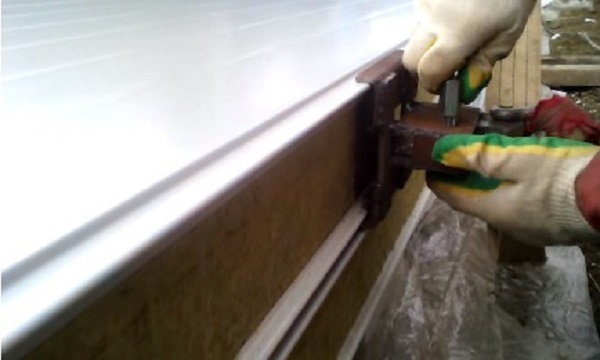 Capture "in the lock" is very dangerous for moving sandwich panels
Capture "in the lock" is very dangerous for moving sandwich panels
Through drilling
This grip is used when the panels are to be mounted vertically. The sandwich panels are drilled, a grip pin is inserted into the hole. The holes that were formed in this case are then hidden behind fittings or fasteners.
This capture method has many disadvantages:
- building material is damaged;
- it is not always possible to achieve accurate drilling of holes on both sides;
- it is necessary to place the pin at an angle of 90 ° to the plane of the panel and parallel to the lifting mechanism.
This lifting method cannot be used for long and heavy panels.
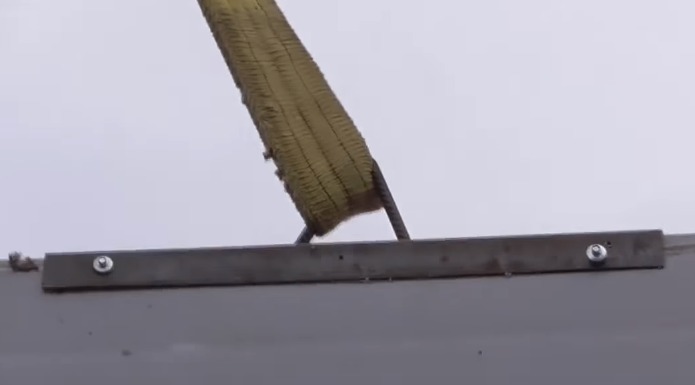 Often builders use this particular capture tool.
Often builders use this particular capture tool.
Video - Homemade grips from channels
Interesting: Repair of the foundation of an old wooden house - we disassemble thoroughly
Installation of wall sandwich panels with a traverse with two grippers ZS1-30-270
1. Warehousing of sandwich panels in bundles Storage of sandwich panels at the construction site is carried out in packs. The use of a traverse with clamping grips minimizes the use of manual labor during the installation of panels. There is no need to manually lift the panel and stand it upright in order to move it to the installation site.
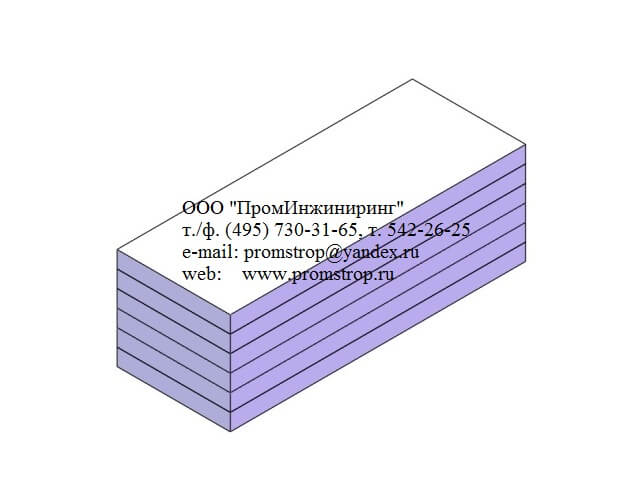
2. Preparation of sandwich panels for installation - Installation of grippers on a horizontally lying panel To prepare the panels for installation, it is necessary to move the top panel of the pack by an amount sufficient to accommodate the clamping grips. Install and tighten the clamps. After that, the panel is lifted using a lifting mechanism. As a result of this lifting, the sandwich panel moves from horizontal to vertical position.

3. Preparation of panels for installation - lifting from horizontal to vertical position As a rule, when preparing sandwich panels for installation, manual labor is used when moving from a horizontal position to a vertical one. The use of clamping grips makes it possible to mechanize this operation as well. 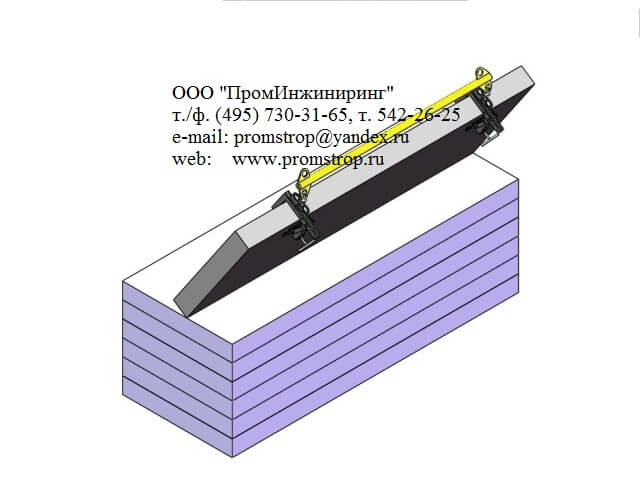
4. Preparing the panels for installation - checking the fastening of the clamping clamps After the sandwich panel takes a vertical position, you should check the reliability of the clamping clamps and the reliability of the connection of the traverse with the clamps with lifting clamps. After that, the sandwich panel is ready for lifting and moving to the place of its installation. 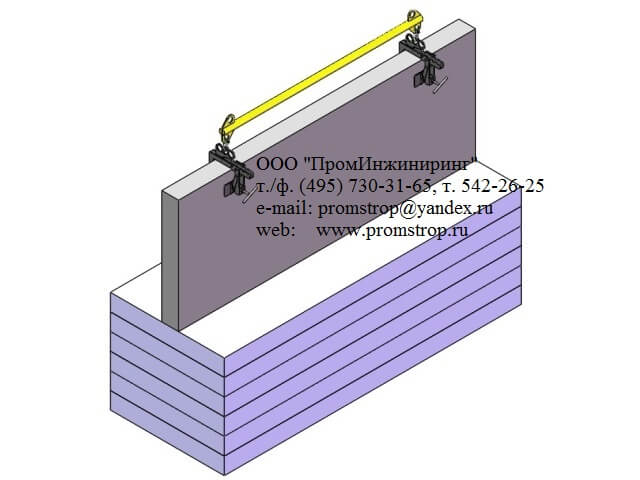
Design and manufacture of lifting equipment in Moscow. Traverses, grips, slings.
125371, Moscow, Volokolamskoe highway, house 112, building 1, building 3 A, office 504
Problems in sandwich panel installation and grapple classification
Details of this group (these include roofing and wall panels) are large and low stiffness. With an increase in the number of layers, the rigidity of the panel decreases, which is associated with the peculiarities of its design.
The sandwich panel includes:
- The outer layer is made of galvanized sheet steel, the outer surface of which receives an additional polymer coating. It gives the products the proper presentation and the required color.
- Two-component adhesive film based on polyurethane compositions.
- Thermal insulator layer - stone or basalt wool - the cross-section of which depends on the initial requirements for the external thermal insulation of the structure.
The number of thermal insulation layers can be different, which determines the thickness of the product. In addition, each manufacturer supplies steel sheets with structural elements for connecting adjacent panels to each other.

Since the stiffness of the middle layer is always minimal, with an increase in the number of layers, the panel deflection under longitudinal load increases, and the risk of deformation increases. The stiffness of the steel sheet is small due to its thickness. Methods to increase rigidity by introducing seals, for example, through ribs along the panel itself, turned out to be unsuccessful, since the final weight of the panel increases dramatically, and its dimensional adjustment "in place" becomes more difficult.
Thus, for any movement of the sandwich panel (according to GOST 32603, the maximum length of the product is 12 meters, with a thickness of 250 mm), using lifting vehicles, only lifting the panel in its longitudinal position is allowed, with grabbing by the side walls, the rigidity of which is quite low.
The clamps for sandwich panels must meet the following requirements:
- Eliminate product deformation during transportation;
- Ensure a reliable clamping of the fixing elements to the outer layer of the panel;
- Provide for the minimum laboriousness of slinging and loosening.
Due to these limitations, the sandwich panel can be gripped in three ways - using flexible textile or synthetic ropes, mechanically, or using vacuum suction cups.
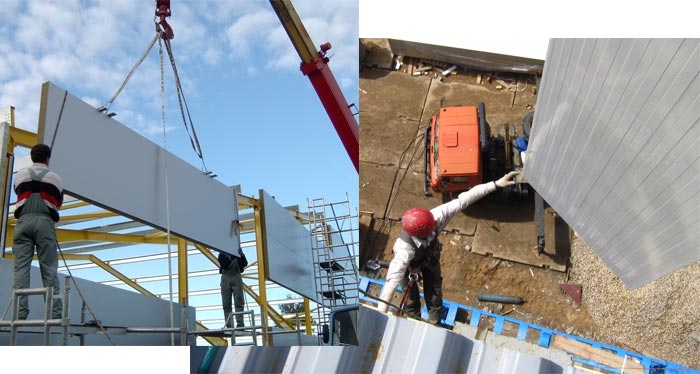
Rope slinging is the cheapest, but also the least practical method. The fact is that sandwich panels come from the manufacturer in a horizontally arranged package in several pieces, so dividing them for slinging with the help of cables is very laborious. In addition, the low rigidity of the structure causes the panel to bend, which in many cases cannot be repaired.
Rope slinging (with ropes of type 2SK) is allowed only in the following cases:
- The number of pairs of textile / synthetic slings must be at least two;
- The angle of the slings must not exceed 60 0;
- Slings are required to be installed on the linear crossbeam of the crane;
- A thick rubber gasket should be provided for each pair of slings;
- The greatest distance between adjacent slings should not be more than 1200 ... 1500 mm.
It is clear that with such restrictions, high-quality lifting of single panels with a length of more than 4 meters is practically impossible, since it will require the use of a specially equipped crane.
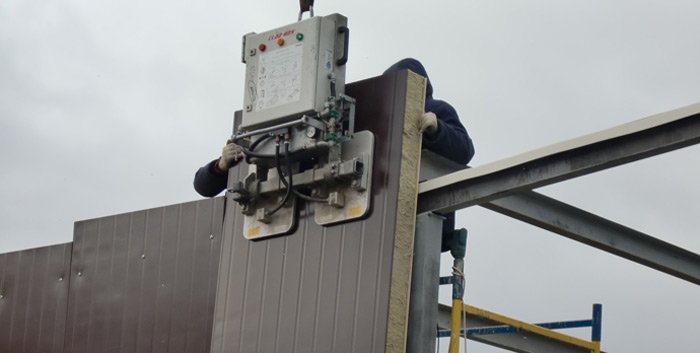
Mechanical and vacuum grippers for sandwich panels remain the best options for lifting and convenient assembly of the structure. Comparing them with each other, it should be noted that the price of mechanical grippers is much lower than vacuum ones, as are the requirements for their operation and routine maintenance. In turn, the grip with the use of suction cups has the most uniform grip and minimizes the risk of surface damage to the panel.
How to make a capture yourself
If it is not possible to purchase a gripper in a store or rent it, then you can make a device yourself.
A homemade tool consists of the following parts:
- lever - controls the force of compression;
- clamping lips;
- movable element - sets the clamping lips in motion;
- main frame.
Homemade clamp - step by step instructions
You can make a clamp from a children's wooden hanger. This will require:
- hanger;
- two hairpins.
A clamp is made in the following sequence:
Step 1. The hanger is divided into two equal parts.
Divide the hanger in half
Step 2. Mark on it the places where you want to insert the pins.
We make markup
Step 3. Drill holes.
Making holes
Step 4. Make a groove for the lock nuts, insert the nuts.
We mount the nuts
Step 5. Insert threaded studs and secure with nuts.
Insert threaded studs
Video - Working with vacuum grippers
Rigging is associated with an increased risk. Therefore, it is necessary to use homemade clamps only in extreme cases and when working with small panels. However, even in this case, it is necessary to follow the safety regulations in order to prevent injury to people working on the construction site.
DIY sandwich panel gripper
To avoid mistakes, read:
The panels should be mounted with thermal rubber bands glued along the entire length of the supporting element and adjacent structures. In the longitudinal joints and in the overlaps of the transverse joint panels, a sealant, mainly butyl rubber tape, must be laid. The use of silicone sealants is not permitted.
When laying panels longer than 12 m, it is permissible to use a crossbeam - traverse. It is allowed to use a one-T or U-beam - the panel is suspended every 3-4 m.
The slope of the roof must also be taken into account in order to avoid damaging the edges of the panels.
Lifting panels to the roof
In the process of laying roofing sandwich panels, the use of a crane is considered the best option.
The lifting of individual panels from the package one at a time must be carried out using specially designed and widely available tools: a carpenter's clamp with a steel plate and a rubber or felt pad, a vacuum gripper.

